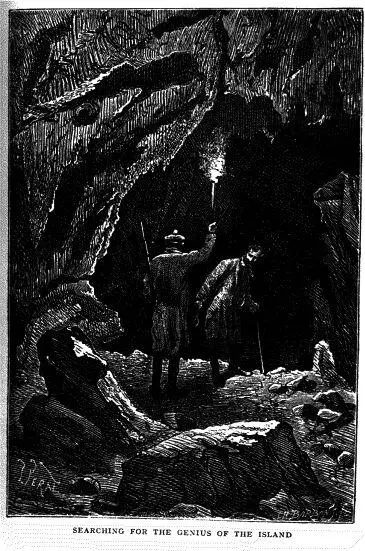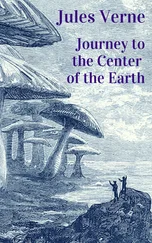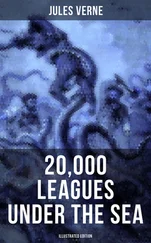
The whole of the valley bordering on the cave, shaded by fir and other trees, was thoroughly explored, and on turning the point of the south-western spur, the colonists entered a narrower gorge similar to the picturesque columns of basalt on the coast. Here the trees were fewer. Stones took the place of grass. Goats and musmons gambolled among the rocks. Here began the barren part of the island. It could already be seen that, of the numerous valleys branching off at the base of Mount Franklin, three only were wooded and rich in pasturage like that of the corral, which bordered on the west on the Falls River valley, and on the east on the Red Creek valley. These two streams, which lower down became rivers by the absorption of several tributaries, were formed by all the springs of the mountain and thus caused the fertility of its southern part. As to the Mercy, it was more directly fed from ample springs concealed under the cover of Jacamar Wood, and it was by springs of this nature, spreading in a thousand streamlets, that the soil of the Serpentine Peninsula was watered.
Now, of these three well-watered valleys, either might have served as a retreat to some solitary who would have found there everything necessary for life. But the settlers had already explored them, and in no part had they discovered the presence of man.
Was it then in the depths of those barren gorges, in the midst of the piles of rock, in the rugged northern ravines, among the streams of lava, that this dwelling and its occupant would be found?
The northern part of Mount Franklin was at its base composed solely of two valleys, wide, not very deep, without any appearance of vegetation, strewn with masses of rock, paved with lava, and varied with great blocks of mineral. This region required a long and careful exploration. It contained a thousand cavities, comfortless no doubt, but perfectly concealed and difficult of access.
The colonists even visited dark tunnels, dating from the volcanic period, still black from the passage of the fire, and penetrated into the depths of the mountain. They traversed these sombre galleries, waving lighted torches; they examined the smallest excavations; they sounded the shallowest depths, but all was dark and silent. It did not appear that the foot of man had ever before trodden these ancient passages, or that his arm had ever displaced one of these blocks, which remained as the volcano had cast them up above the waters, at the time of the submersion of the island.

However, although these passages appeared to be absolutely deserted, and the obscurity was complete, Cyrus Harding was obliged to confess that absolute silence did not reign there.
On arriving at the end of one of these gloomy caverns, extending several hundred feet into the interior of the mountain, he was surprised to hear a deep rumbling noise, increased in intensity by the sonorousness of the rocks.
Gideon Spilett, who accompanied him, also heard these distant mutterings, which indicated a revivification of the subterranean fires. Several times both listened, and they agreed that some chemical process was taking place in the bowels of the earth.
“Then the volcano is not totally extinct?” said the reporter.
“It is possible that since our exploration of the crater,” replied Cyrus Harding, “some change has occurred. Any volcano, although considered extinct, may evidently again burst forth.”
“But if an eruption of Mount Franklin occurred,” asked Spilett, “would there not be some danger to Lincoln Island?”
“I do not think so,” answered the reporter. “The crater—that is to say, the safety-valve, exists, and the overflow of smoke and lava would escape, as it did formerly, by its customary outlet.”
“Unless the lava opened a new way for itself towards the fertile parts of the island!”
“And why, my dear Spilett,” answered Cyrus Harding, “should it not follow the road naturally traced out for it?”
“Well, volcanoes are capricious,” returned the reporter.
“Notice,” answered the engineer, “that the inclination of Mount Franklin favours the flow of water towards the valleys which we are exploring just now. To turn aside this flow, an earthquake would be necessary to change the mountain’s centre of gravity.”
“But an earthquake is always to be feared at these times,” observed Gideon Spilett.
“Always,” replied the engineer, “especially when the subterranean forces begin to awake, as they risk meeting with some obstruction, after a long rest. Thus, my dear Spilett, an eruption would be a serious thing for us, and it would be better that the volcano should not have the slightest desire to wake up. But we could not prevent it, could we? At any rate, even if it should occur, I do not think Prospect Heights would be seriously threatened. Between them and the mountain, the ground is considerably depressed, and if the lava should ever take a course towards the lake, it would be cast on the downs and the neighbouring parts of Shark Gulf.”
“We have not yet seen any smoke at the top of the mountain, to indicate an approaching eruption,” said Gideon Spilett.
“No,” answered Harding, “not a vapour escapes from the crater, for it was only yesterday that I attentively surveyed the summit. But it is probable that at the lower part of the chimney, time may have accumulated rocks, cinders, hardened lava, and that this valve of which I spoke, may at any time become overcharged. But at the first serious effort, every obstacle will disappear, and you may be certain, my dear Spilett, that neither the island, which is the boiler, nor the volcano, which is the chimney, will burst under the pressure of gas. Nevertheless, I repeat, it would be better that there should not be an eruption.”
“And yet we are not mistaken,” remarked the reporter. “Mutterings can be distinctly heard in the very bowels of the volcano!”
“You are right,” said the engineer, again listening attentively. “There can be no doubt of it. A commotion is going on there, of which we can neither estimate the importance nor the ultimate result.”
Cyrus Harding and Spilett, on coming out, rejoined their companions, to whom they made known the state of affairs.
“Very well!” cried Pencroft, “the volcano wants to play his pranks! Let him try, if he likes! He will find his master!”
“Who?” asked Neb.
“Our good genius, Neb, our good genius, who will shut his mouth for him, if he so much as pretends to open it!”
As may be seen, the sailor’s confidence in the tutelary deity of his island was absolute, and, certainly, the occult power, manifested until now in so many inexplicable ways, appeared to be unlimited; but also it knew how to escape the colonists’ most minute researches, for, in spite of all their efforts, in spite of the more than zeal,—the obstinacy,—with which they carried on their exploration, the retreat of the mysterious being could not be discovered.
From the 19th to the 25th of February the circle of investigation was extended to all the northern region of Lincoln Island, whose most secret nooks were explored. The colonists even went the length of tapping every rock. The search was extended to the extreme verge of the mountain. It was explored thus to the very summit of the truncated cone terminating the first row of rocks, then to the upper ridge of the enormous hat, at the bottom of which opened the crater.
Читать дальше














